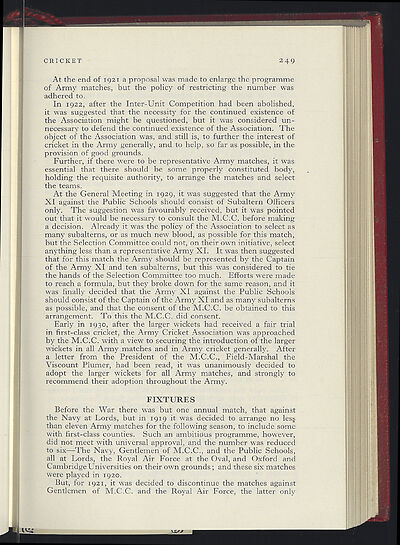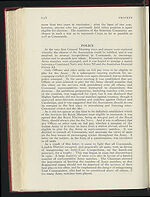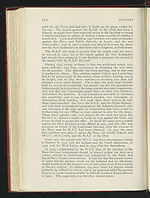1938-39
(267)
Download files
Complete book:
Individual page:
Thumbnail gallery: Grid view | List view

CRICKET
2
49
At the end of
1921
a proposal was made to enlarge the programme
of Army matches, but the policy of restricting the number was
adhered to.
In
1922,
after the Inter-Unit Competition had been abolished,
it was suggested that the necessity for the continued existence of
the Association might be questioned, but it was considered un-
necessary to defend the continued existence of the Association. The
object of the Association was, and still is, to further the interest of
cricket in the Army generally, and to help, so far as possible, in the
provision of good grounds.
Further, if there were to be representative Army matches, it was
essential that there should be some properly constituted body,
holding the requisite authority, to arrange the matches and select
the teams.
At the General Meeting in
1929,
it was suggested that the Army
XI against the Public Schools should consist of Subaltern Officers
only. The suggestion was favourably received, but it was pointed
out that it would be necessary to consult the M.C.C. before making
a decision. Already it was the policy of the Association to select as
many subalterns, or as much new blood, as possible for this match,
but the Selection Committee could not, on their own initiative, select
anything less than a representative Army XI. It was then suggested
that for this match the Army should be represented by the Captain
of the Army XI and ten subalterns, but this was considered to tie
the hands of the Selection Committee too much. Efforts were made
to reach a formula, but they broke down for the same reason, and it
was finally decided that the Army XI against the Public Schools
should consist of the Captain of the Army XI and as many subalterns
as possible, and that the consent of the M.C.C. be obtained to this
arrangement. To this the M.C.C. did consent.
Early in
1930,
after the larger wickets had received a fair trial
in first-class cricket, the Army Cricket Association was approached
by the M.C.C. with a view to securing the introduction of the larger
wickets in all Army . matches and in Army cricket generally. After
a letter from the President of the M.C.C., Field-Marshal the
Viscount Plumer, had been read, it was unanimously decided to
adopt the larger wickets for all Army matches, and strongly to
recommend their adoption throughout the Army.
FIXTURES
Before the War there was but one annual match, that against
the Navy at Lords, but in
1919
it was decided to arrange no less
than eleven Army matches for the following season, to include some
with first-class counties. Such an ambitious programme, however,
did not meet with universal approval, and the number was reduced
to six—The Navy, Gentlemen of M.C.C., and the Public Schools,
all at Lords, the Royal Air Force at the Oval, and Oxford and
Cambridge Universities on their own grounds; and these six matches
were played in
1920.
But, for
1921,
it was decided to discontinue the matches against
Gentlemen of M.C.C. and the Royal Air Force, the latter only
2
49
At the end of
1921
a proposal was made to enlarge the programme
of Army matches, but the policy of restricting the number was
adhered to.
In
1922,
after the Inter-Unit Competition had been abolished,
it was suggested that the necessity for the continued existence of
the Association might be questioned, but it was considered un-
necessary to defend the continued existence of the Association. The
object of the Association was, and still is, to further the interest of
cricket in the Army generally, and to help, so far as possible, in the
provision of good grounds.
Further, if there were to be representative Army matches, it was
essential that there should be some properly constituted body,
holding the requisite authority, to arrange the matches and select
the teams.
At the General Meeting in
1929,
it was suggested that the Army
XI against the Public Schools should consist of Subaltern Officers
only. The suggestion was favourably received, but it was pointed
out that it would be necessary to consult the M.C.C. before making
a decision. Already it was the policy of the Association to select as
many subalterns, or as much new blood, as possible for this match,
but the Selection Committee could not, on their own initiative, select
anything less than a representative Army XI. It was then suggested
that for this match the Army should be represented by the Captain
of the Army XI and ten subalterns, but this was considered to tie
the hands of the Selection Committee too much. Efforts were made
to reach a formula, but they broke down for the same reason, and it
was finally decided that the Army XI against the Public Schools
should consist of the Captain of the Army XI and as many subalterns
as possible, and that the consent of the M.C.C. be obtained to this
arrangement. To this the M.C.C. did consent.
Early in
1930,
after the larger wickets had received a fair trial
in first-class cricket, the Army Cricket Association was approached
by the M.C.C. with a view to securing the introduction of the larger
wickets in all Army . matches and in Army cricket generally. After
a letter from the President of the M.C.C., Field-Marshal the
Viscount Plumer, had been read, it was unanimously decided to
adopt the larger wickets for all Army matches, and strongly to
recommend their adoption throughout the Army.
FIXTURES
Before the War there was but one annual match, that against
the Navy at Lords, but in
1919
it was decided to arrange no less
than eleven Army matches for the following season, to include some
with first-class counties. Such an ambitious programme, however,
did not meet with universal approval, and the number was reduced
to six—The Navy, Gentlemen of M.C.C., and the Public Schools,
all at Lords, the Royal Air Force at the Oval, and Oxford and
Cambridge Universities on their own grounds; and these six matches
were played in
1920.
But, for
1921,
it was decided to discontinue the matches against
Gentlemen of M.C.C. and the Royal Air Force, the latter only
Set display mode to:
![]() Universal Viewer |
Universal Viewer | ![]() Mirador |
Large image | Transcription
Mirador |
Large image | Transcription
| Games and sports in the army > 1938-39 > (267) |
|---|
| Permanent URL | https://digital.nls.uk/248740077 |
|---|
| Description | 'Games and Sports in the Army' was an annual publication produced by the British War Office between the 1930s and 1960s. This included the Second World War. It outlines the rules and regulations for games and sports played by members of the armed forces. It features names and photographs of team members, and examples of contemporary advertising. |
|---|---|
| Shelfmark | GWB.52 |

